In A Nation Awash In Eggs, A State Struggles To Get Them To Children
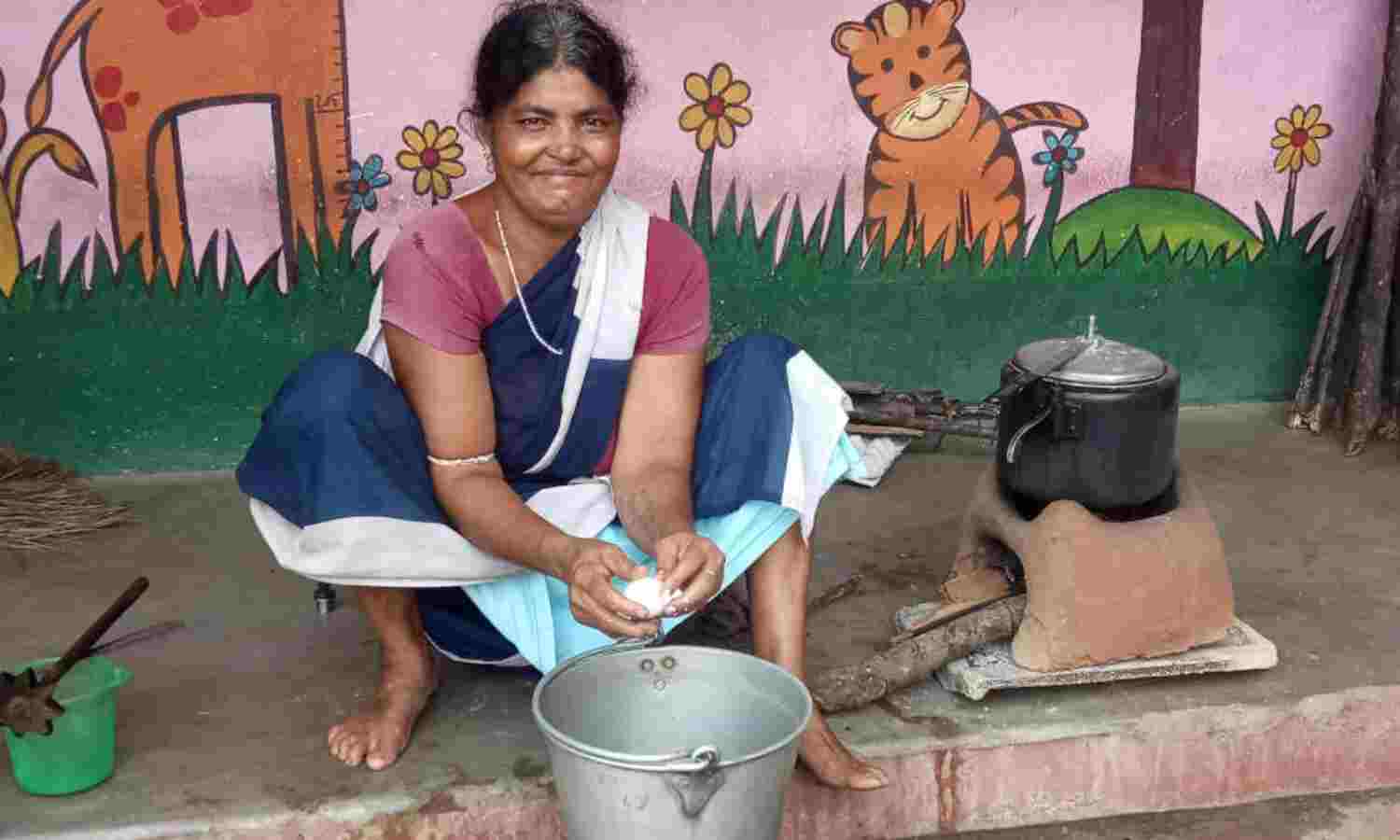
Angul, Odisha: When Rebati Naik, 23, was pregnant she received chatua (a mixture of dry pulses and cereals), ladoos made of almonds, and eight eggs per month as the ‘take-home’ ration under the government’s supplementary nutrition programme, four fewer eggs than she is entitled to. Now her son, Shyam Naik, is nine months old, and she also receives sooji (semolina), as part of the ration.
Eggs are rich sources of digestible protein, vitamin A and B12, important for maternal and child nutrition, and the nutrition program in Odisha provides 12 eggs to pregnant and lactating mothers until the child is six months old. The child receives 12 eggs once but all through her pregnancy and now her lactation, Rebati Naik received four eggs fewer than she is entitled to. These eggs are first shared with her husband, mother-in-law and two brothers-in-law. “I get eight eggs a month, we make a curry and eat it together,'' Naik said. She eats last, depriving herself of an important source of nutrients.
This is especially important in Angul district in Odisha--where 31.8% of children under five years were stunted (short for their age), and 37.4% were anaemic in 2015, data from National Family Health Survey 4 (NFHS 4) show. Across India, pregnant woman, lactating mothers and children need better nutrition--38.4% children across India were stunted, 35.8% underweight, and 58.6% anaemic in 2015-16, NFHS 4 data show.
The government’s supplementary nutrition programme, under the Integrated Child Development Services (ICDS), started in 1975, entitles every pregnant woman, lactating mother and child, three-to-six years old, take-home rations and hot cooked meals to help support in a child’s first 1,000 days--a window of opportunity in early childhood when a child’s growth and cognitive development is maximum.

Eggs provide important nutrients but few women, children consume eggs in India
Eggs are a rich source of easily digestible protein such as essential fatty acids, vitamin A and B12, hormones and immunity-increasing substances, readily absorbed and metabolised by the mother’s body. Eating eggs helps increase the nutritive value of breast-milk, helping child growth.
Eggs are relatively easy to obtain, adaptable to many different types of cooking techniques and an affordable source of highly digestible protein, according to a 2018 study on sustainable methods of egg production by Kalpana Beesabathuni, Srujith Lingala and Klaus Kraemer of Sight and Life, a nutrition think tank based in Switzerland.
In most low-income countries, consumption of eggs among women of reproductive age was found to be very low, especially among women from households in the lower wealth quintiles, according to a 2018 study by the International Food Policy Research Institute (IFPRI), a research advocacy based in Washington D.C.
While India is the third-largest producer of eggs in the world, 14.7% of children consumed eggs in a 24‐hour period before the survey, a level much lower than other South Asian countries (25%), the study found. Despite eggs being cheaper in India than other South Asian countries, only 19% of mothers who said they ate eggs, consumed an egg in the 24-hour period before the survey.
Steady growth in demand of eggs has kept prices lower in India than other South Asian countries--it is 4.7 times as expensive as rice, according to the 2007 study on the poultry industry by R.G Nambiar and Rajesh Mehta for the Research and Information System for Developing Countries, a policy research institute based in Delhi. In the rest of South Asia, eggs are around six times as expensive as rice. In sub‐Saharan Africa, the world's poorest region, eggs are 9.5 times as expensive as cereals, on average, the study found.
| In India, Only 14.7% of Children Consumed Eggs in a 24‐Hour Recall Period | |||
|---|---|---|---|
| Category | Eggs available for consumption per capita per year | Children, 6-23 months, who consumed an egg in a 24-hr recall period (In %) | Ratio of egg price to cereal price |
| High-income countries | 265 | NA | 2.3 |
| Latin America and the Carribean | 218 | 42.8 | 4.8 |
| Middle East and North Africa | 129 | 30.8 | 5.4 |
| Eastern Europe and Central Asia | 238 | 34 | 3.6 |
| East Asia | 241 | 20.8 | 7.1 |
| South Asia excluding India | 50 | 25 | 5.9 |
| India | 52 | 14.7 | 4.7 |
| Sub- saharan Africa | 40 | 12.6 | 9.5 |
Source: 2018, An egg for everyone: Pathways to Universal Access to One of Nature’s Most Nutritious Food, IFPRI
In India, Odisha provides the second highest number of eggs to children
Of the 10 states with the highest proportion of stunted children in India, only three--Bihar, Jharkhand and Karnataka--provide eggs to children as part of the supplementary nutrition programme, as IndiaSpend reported in July 2018. Of all states that provide eggs, Odisha which has the 13th highest proportion of stunted children, provides the second-highest number of eggs to children in anganwadis.
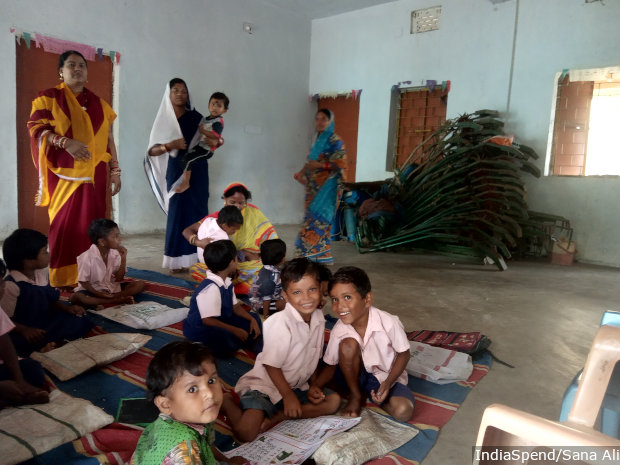
In Nandapur village in Odisha’s Angul district, anganwadi worker Sushma Rao (left) at a make-shift centre, where equipment for the Odisha Livelihood Mission is kept. Only 11 of 22 children enrolled were present in class; the centre is too far for the rest to attend regularly.
Odisha has 34.1% of children under five who are stunted as compared to Uttar Pradesh (UP) with 46.3% of its children stunted. UP does not give eggs as part of the scheme.
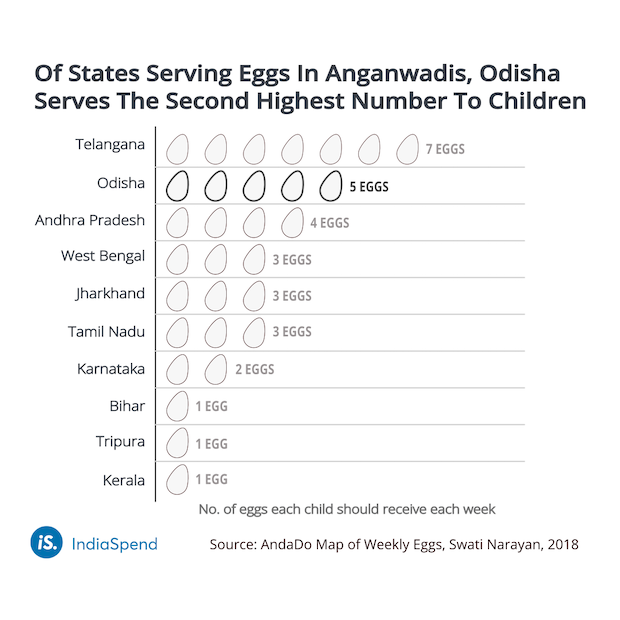
Many women, children don’t receive take-home rations, hot cooked meals
Rebati Naik lives 4 km away from the village anganwadi centre. She said she doesn’t know when the take-home ration is distributed and is often late to receive her share. “We are not told by the anganwadi didi when the ration is distributed and it is sometimes finished by the time we reach the centre,” she said.
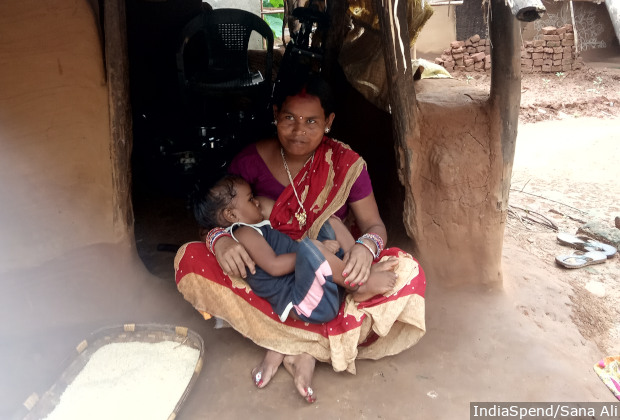
Rebati Naik, 23, of Maanpur village, Angul district, Odisha feeds her nine-month-old baby. Because she lives far from the anganwadi, she did not know where to register for the take-home rations provided by the government. It took her three months to register at the anganwadi.
It took three months for Naik to register herself at the anganwadi centre, and she didn’t receive the take-home ration for these three months. “We do not have an anganwadi in our village, so we did not know where to go,” said Bhishu Naik, 28, Rebati’s husband, and an agricultural labourer.
More than half of the women did not receive take-home rations before the fifth of every month, as the guidelines of the programme stipulate. Nearly one-fourth received the take-home rations after the 20th of the month.
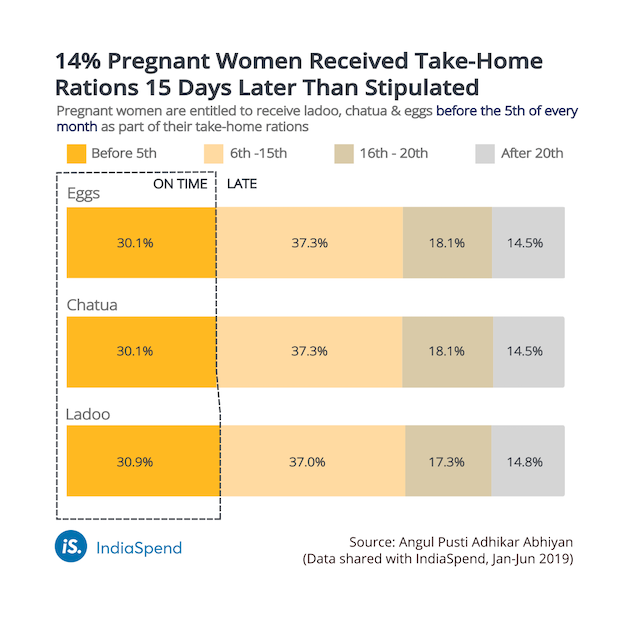
For the take-home rations, eggs are received once a month, through a company that won the government tender.
“We are only given Rs 7.70 per child per day for hot cooked meals,” said Anita Das, 40, an anganwadi worker in Maanpur village of Angul district. “We have to procure eggs from the open market at Rs 5, and sometimes even Rs 6, for the hot cooked meals. We are only left with Rs 2.70 in which we have to manage morning snacks, rice, dal, oil and haldi.
“The number of eggs were increased by the government from eight to 12 in 2018 but the rates have not been increased accordingly. We have to sometimes make adjustments from the take-home ration so that the children who come to the centre do not go hungry,” she said.
In one anganwadi centre in Nandpur in Angul, where three- to six-year-olds shared the area with tools and equipment from Odisha’s livelihood mission, only 11 children attended out of 22 enrolled at the centre. Most of the children not in attendance were from, Namogo, another village; 3 km away, which does not have an anganwadi of its own.
As these children cannot walk alone to reach the centre, they miss out on their hot cooked meal of morning snacks, egg, chattua and semolina. The leftover eggs are given to the children who come to the anganwadi, said Sushma Rao, 42, an anganwadi worker at the centre, but this could not be independently confirmed.
Earlier, this anganwadi operated under a tree or at someone’s house, and now it operates at a panchayat (village committee) meeting hall, Rao said. “We were allotted the panchayat meeting hall after five years, we still don't have a designated anganwadi centre. I have made several attempts to request the sarpanch (village head) to find a solution, but we have been told there is no land available for the anganwadi,” Rao said.
Anita Pradhan, 39, the village head, was oblivious of the situation, and asked us to speak to her husband about the issue. “I have spoken to the child development project officer and we have been told to identify the land for the anganwadi centre ourselves,” said Jayant Pradhan, 44, Anita Pradhan’s husband. “But there is no land left in the village.”
(Ali is a reporter with IndiaSpend.)
We welcome feedback. Please write to respond@indiaspend.org. We reserve the right to edit responses for language and grammar.


